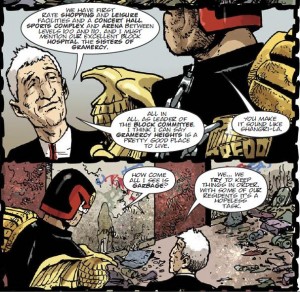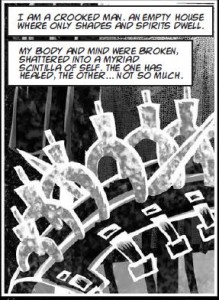Here is a shameful confession from a UK-resident comics fan: I’ve never actually read 2000AD.
I’ve read copious amounts of Judge Dredd and some Future Shocks in TPBs, but haven’t read them or any other comics in 2000AD’s serialized format. So when I saw this week’s issue, Prog 1900 (2000AD issues are called “progs”), being advertised as a jumping-on point for new readers, it seemed like a good time to start reading.
The magazine has been running for thirty-seven years, though, which means that it’s up against that familiar problem: how do you encourage people to dive into a continuity that may be even older than they are?
The first step, of course, is picking a good cover, for which 2000AD has shrewdly chosen a close-up of Judge Dredd getting rained on. Since British and British-media-aware nerds have certainly heard of Dredd, this provides a familiar reference point. It also alerts readers to the grimness of the worlds within; whether they’re in the future or the past, you would not want to live in the setting of a 2000AD story, usually because of all the gory death.
Prog 1900 contains the first installments of three new stories. There are brief explanatory notes at the start of the prog introducing the stories and their respective protagonists and settings. The first story, “Judge Dredd: Block Judge,” takes place in the year 2136 in Mega-City One: the hyper-urbanized future incarnation of New York and the surrounding areas.
There are some previous-knowledge-required terms in here, mostly in a newspaper headline in the first panel. A judge has been shot dead and “consigned to Resyk” (the large recycling plant where people’s dead bodies are sent); six years before the incident, the shooter was beaten by a “futsie” (short for “future shock”—someone whose mind snaps under the stress of living in a future where most things are terrible). Other than that, it seems like a fairly transparent entry point into the world of Dredd.
 In this prog, Dredd and a fellow Judge are sent to impose the law on an out-of-control city block where robbery and murder are part of everyday life. The presence of the smooth-talking leader of the Block Committee, who tries to gloss over the horrific conditions in the block and may not be entirely honest with the accounts, suggests that the Judges might have more to deal with than just keeping the block inhabitants in line. A series of smaller panels on the last two pages creates a sense of unrelenting crime and misery, to the point where we barely need the narration boxes telling us that “the work of the Block Judge is hectic—barely time to catch a breath.” The panels already make us feel as though we’re watching a fight that’s never going to end. However, I love third-person narration boxes beyond reason, so these can stay.
In this prog, Dredd and a fellow Judge are sent to impose the law on an out-of-control city block where robbery and murder are part of everyday life. The presence of the smooth-talking leader of the Block Committee, who tries to gloss over the horrific conditions in the block and may not be entirely honest with the accounts, suggests that the Judges might have more to deal with than just keeping the block inhabitants in line. A series of smaller panels on the last two pages creates a sense of unrelenting crime and misery, to the point where we barely need the narration boxes telling us that “the work of the Block Judge is hectic—barely time to catch a breath.” The panels already make us feel as though we’re watching a fight that’s never going to end. However, I love third-person narration boxes beyond reason, so these can stay.
The original creative team—John Wagner on writing and Carlos Ezquerra on art—are back together for this prog, which is probably how so much information could be conveyed in such a short time. They know Dredd’s world inside out, and are thus able to immerse the reader in it even if they only have a few pages to make that happen.
At the end, I was curious about what direction this story would take in future progs. Would it venture into J.G. Ballard territory? Would some kind of horrible epidemic break out? That’s how a successful serialized story should make the reader feel, and I look forward to seeing what happens next.
The second story in this issue, with scripting by Ian Edgington and art by D’Israeli, is “Stickleback: Thru’Penny Opera,” which takes us back in time to late nineteenth-century London. The title character, Stickleback, is a “master criminal . . . [who] led a gang of freaks, oddballs and supernatural entities that had the city under their thumb.” Before the events of this prog, he died and was brought back to life five years later in the service of a secret society.
In this installment, we meet a devilish-looking man who kills gods for three mysterious women, watch a fight unfold in Stickleback’s house, and find a crazed killer. That’s as much as I can say, because a) I don’t want to spoil the whole story and b) that’s the sum total of my understanding. I wondered if the events described in the explanatory notes informed what was happening in this story, but had no clear indication one way or the other.
For some reason, Stickleback wears a plague doctor-esque mask and a sort of artificial external spine when appearing in public, and is constantly bent over to give himself the appearance of someone with a disability. However, we aren’t given any background on why he has to wear such a presumably uncomfortable disguise. Did he always dress like that? Is it a recent development, perhaps related to his contact with the secret society? Isn’t the mark of a master criminal that they can walk around in broad daylight without anyone laying a finger on them? These aren’t leave-you-wanting-more questions; they’re “Did I miss something?” questions.
A little more explanation in the story itself would have helped. We don’t need a character detailing her or his entire life story to a reader stand-in, but, if the backstory is extremely complex, a bit of “what” and “why” goes a long way. If the individual progs were longer, this probably wouldn’t be necessary—in full-length comics, characters don’t have to explain their histories as much because the format allows more time for stories to unfold organically. 2000AD progs don’t have that luxury.
 That said, the art is unsettling in a great way. If you want people who look somehow wrong or off but can still compel you to watch them throughout a story, D’Israeli is your guy. Everything is black, white, and gray with eerie askew lines and a cutout-ish appearance. As a result, characters don’t quite look human and seem dissociated from their surroundings. The dying gods are outlined in white, as though they’re already ghosts.
That said, the art is unsettling in a great way. If you want people who look somehow wrong or off but can still compel you to watch them throughout a story, D’Israeli is your guy. Everything is black, white, and gray with eerie askew lines and a cutout-ish appearance. As a result, characters don’t quite look human and seem dissociated from their surroundings. The dying gods are outlined in white, as though they’re already ghosts.
If future progs can clarify what’s going on with Stickleback and his supporting cast, I’d be interested in reading more (although this is largely so I can keep looking at D’Israeli’s art).
The last story in Prog 1900 is “Kingdom: Aux Drift,” written by Dan Abnett and with art by Richard Elson and Abigail Ryder. The protagonist of “Kingdom: Aux Drift” is named, delightfully, Gene the Hackman. The explanatory notes tell us that Gene is part of a unit of literal “dog soldiers”: genetically engineered human-animal fighters. The concept probably draws from narratives such as the 2002 movie Dog Soldiers (Neil Marshall), wherein Ser Davos from Game of Thrones is a soldier who turns into a werewolf. Given that the real-life Dog Soldiers were an elite Plains Indian military unit, though, I’m not one hundred percent sure how I feel about that.
At any rate, this is a standard post-apocalyptic scorched-earth story wherein Gene meets two pilots in a WWI-esque plane who’ve crashed on his “walk-around” route in Auxtralia (one of my favorite things about 2000AD is how thinly the names of people and places are fictionalized). There are giant bugs, some fighting, and lots of Australian outback-style rocks.
A third-person narration box containing what I assume to be Gene’s speech patterns is a nice touch. Gene thinks in mostly standard English with occasional deviations; for instance, he remembers having to keep the giant bugs “out of the cold place where the masters slept, long time.” I think Abnett could have actually distanced Gene’s syntax and word choice further from how we speak today to give the impression of being in a completely different time and place and to play with the idea of what constitutes “standard” language.
Even though a lot happens in these few pages, the action didn’t quite grab me, probably because the pace slows significantly when Gene and the pilots spend most of a page talking. If they were filling in new readers on how this world worked, it would be fine. However, their conversation seems more like they’re drawing on history from earlier progs, which isn’t really necessary at this point in time.
As with the previous story, the standout feature of “Kingdom: Aux Drift” is the art. The characters are drawn well, and the prog is a refreshing burst of color after the monochrome darkness of Stickleback’s London. Even though the dominant color scheme is some combination of reds and browns, Gene is gray with bright blue markings and always stands out against his backgrounds. Elson and Ryder’s Auxtralia is a vivid place with space to breathe and, despite being made mostly of rocks and dust, it looks alive.
Overall, I enjoyed my first foray into this British comics phenomenon. Even though some plot points and character elements could have been made clearer, I’d still like to read future progs to see where the stories go. I should also note that the story concepts in this prog were all noticeably different from each other, which meant that the stories complemented one another rather than rehashing the same idea three times. This variety and the best parts of the prog can interest new readers in finding out what 2000AD’s other stories are like—which means that they’ll keep reading.

